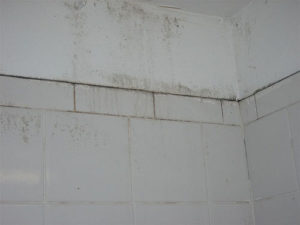Steamy.
Fog clouding up the mirror.
You might think I’m describing a scene out of Fifty Shades of Grey but nope; plot twist! I’m talking about mold’s favorite place to grow.
(Not where you thought I was going, was it?)
Bathroom mold is a common problem in homes all across Chicago.
It can be a pain to deal with and even worse, it can actually cause problems with your family’s health. As luck would have it, you’ve found your way here and we can help, but first, let’s talk about the basics of bathroom mold.
Bathroom Mold Basics
The most common mold found in bathrooms is black mold.
Whoah.
Settle down.
I’m not talking about the black mold (Stachybotrys chartarum), I’m talking about mold that’s black in color. It’s very common and you’ve probably seen it at some point in your life.
Before you start packing the kids up and heading to grandma’s to escape, realize that most black mold found in bathrooms is nontoxic and what we call surface mold. Examples of this would be mold found on your shower curtain, on your caulk, or on the tiles or porcelain of your shower and bathtub.
You probably only need to be concerned about the toxic kind if you’ve had a leak go unnoticed for an extended period of time or if the place has been flooded recently. If you live in the Chicago area you might be all too familiar with flooding due to all the pipes bursting from the recent cold temps.
However, there’s no way to know for sure what type of mold you’re dealing with without an inspection.
Over-the-counter DIY mold inspection kits are sold but we don’t recommend them. They produce a lot of false positives and that can lead to unneeded costs.
Your best best is to call a team of certified mold inspectors to have them perform a few tests such as air sampling and lift tape tests to see what you’re working with.
If it does happen to be the toxic kind, you need to leave the remediation to the professionals. When mold is disturbed, it releases spores into the air and in return anyone in the area can breathe them in.
If it’s just the gross kind of mold that’s grown because you haven’t washed your shower curtain in a while, you can take some steps to get rid of it yourself.
Tips for Bathroom Mold Removal
Once you’ve determined you aren’t dealing with Stachybotrys chartarum, you can start your bathroom mold battle plan.
I know there are several cleaning products on the shelves touting the latest and greatest in mold removal, but I’ll tell you a secret.
Soap, water and vinegar all work just as well (most of the time).
Save yourself some money and breathe easier (nobody wants to be breathing bleach or Tilex in all day) by purchasing natural household cleaners.
First, spray vinegar on any patches of mold you’ve discovered in the bathroom. The vinegar’s natural acidic quality will eat away at the mold so spray it on and take a break. Let the vinegar work its magic as it soaks into the mold.
After a few minutes, you can go back in with soap and hot water and proceed to wipe the rest of the mold away.
The key to mold removal is prevention. Mold is a sneaky little sucker and will try and find a way to grow back if you don’t get all of the patches you see. Mold spores can spread pretty rapidly so making sure you’ve cleaned up all the areas is vital in preventing the mold from growing back. In addition, make sure your bathroom is properly ventilated. All the fog and warmth you feel when you step out of the shower is caused by moisture in the air, which in turn is the final key to the surface mold growth in your shower or tub.
Calling in the Professionals
If getting rid of your bathroom mold is too overwhelming or if you just don’t feel like dealing with it yourself, give us a call.
We offer inspections and individualized plans because we know each house is its own unique situation and want to do our best for you.
Do you have more questions about mold? Interested in having your house inspected? Contact us today!








